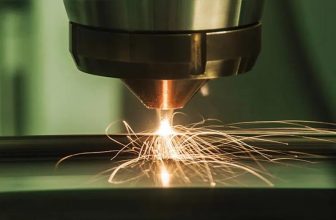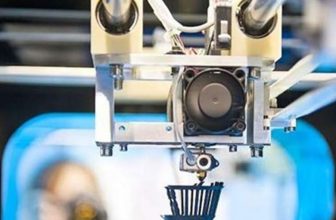
In addition to anti-corrosion effects, the silver-white and golden-yellow coatings on general metal electroplating also have special functions such as wear resistance, self-lubrication, easy demoulding and convenient welding, and are also effective means to beautify products.
The emergence of electroplating ideally meets people’s needs for decorative protection of metal surfaces. The usual method is to immerse the parts in the electrolytic solution of the metal to be plated and connect to the negative electrode, and apply a certain DC voltage to form a layer on the surface of the part. Metal plating is required, and this process is called electroplating. Commonly used electroplating in the industry includes zinc plating, chrome plating, copper plating, silver plating, gold plating and so on. The thickness of the electroplating layer can be determined according to needs, generally ranging from 10 μm to 100 um. Now the combination of 3D printing rapid manufacturing and electroplating process has greatly enriched the product form.
Introduction to silver plating and gold plating
Silver (Ag) is a white metal extracted from natural silver and other silver minerals. It is a precious metal with a long history of application. It has a history of more than 4,000 years. Because of the unique excellent characteristics of silver, people have given it double value of currency and decoration. The pound sterling and the silver circle used before the liberation of our country are silver and copper alloys based on silver. Silver has a white luster, is not easy to oxidize, and its reflectivity can reach 91%. It is widely used in jewelry and decorations. The reflectance of silver to visible light is 91%, while platinum is 69% and palladium is 57%. The high reflectivity shows high brightness, so the white luster of silver is very eye-catching. Pure silver has an interesting feature. The anti-oxidation and durability of silver jewelry are also related to the personal physique. People with good physique will wear brighter, and if the physique is weaker and there are more toxins in the body, silver jewellery will soon be released. Black, just like ancient people used silver needles to test whether the wine is poisonous, poisonous silver needles will turn black, so wearing sterling silver jewelry from time to time can expel toxins from the body, killing two birds with one stone. In addition, silver has always had anti-virus functions. According to experts, modern medical research has confirmed that silver can form positively charged silver ions in water. These silver ions can adsorb bacteria on them, and make the enzymes that bacteria rely on to breathe inoperative and make bacteria unable to survive. According to scientific research, Typhoid bacilli can only survive on silver tablets for 1 hour, and diphtheria bacilli can only survive on silver tablets for 3 hours. Silver is known as a “permanent fungicide” because of its strong bactericidal ability.
Gold (Au) is the most familiar precious metal and one of the softest metals. It has very good electrical conductivity, is not easy to corrode and rust, has strong acid resistance, has excellent infrared reflectivity, maximum ductility and malleability. . The appearance of the gold-plated layer is golden yellow and has high chemical stability. It only dissolves in “aqua regia” and other super acids, but is insoluble in other acids. The gold-plated layer has good ductility, easy polishing, high temperature resistance, and good discoloration resistance.
The performance of silver and gold plating
Silver and silver plating
- The hardness of silver: 2.7
- Density: 10.5
- Melting point: 960.5 degrees
- Relative atomic mass: 107.9
- Standard electrode potential Ag /Ag: +0. 799V.
Silver is malleable and plastic, and has excellent ductility, electrical conductivity and thermal conductivity. The polished silver layer is highly reflective and decorative. The technology of plating silver on glass and metal surfaces aims to take advantage of the excellent electrical conductivity, corrosion resistance and light-reflecting properties of metallic silver. Silver is a face-centered cubic lattice, with good plasticity, second only to gold in ductility, but when it contains a small amount of arsenic (As), antimony (Sb), and bismuth (Bi), it becomes very brittle. Silver has good chemical stability and does not oxidize at room temperature. But among all precious metals, silver has the most active chemical properties. It can dissolve in nitric acid to generate silver nitrate; it is easily soluble in hot concentrated sulfuric acid and slightly soluble in hot dilute sulfuric acid; it forms chlorination on the surface in hydrochloric acid and “aqua regia” Silver film; when in contact with sulfide, black silver sulfide is formed. In addition, silver can form alloys with any proportion of gold or copper. It is very easy to form alloys when eutectic with copper and zinc, and silver amalgam can be formed when it comes in contact with mercury.
There are two types of conventional silver plating: electroless plating and electroplating.
Electroless silver plating is to reduce the monovalent silver in the silver ammonia complex ion [Ag(NH3),]+ with tartaric acid or sugar, so that the metallic silver is deposited on the glass to produce a bright silver mirror. The silver plating of thermos is a typical example of electroless silver plating. Because the silver plating layer is bright and reflective, the infrared radiation generated by the heat can be reflected back well to achieve a better heat preservation effect. Therefore, the silver-plated kettle has better heat preservation effect.
Electrolytic silver plating uses silver cyanide ion [Ag(CN)2] as an electrolyte, and deposits metallic silver on the surface of other metals by electrolysis.
There are many advantages of silver plating that are not noticed by people. For example, silver plating on wind instruments not only makes it look whiter, but also sounds more beautiful.
Gold and gold-plated
The atomic number of gold is 79, density: 19.302 g/cmn (20 C), melting point: 1063 C. Relative atomic mass: 196.97, standard electrode potential Au+ /Au is +1.68 v, and valence is +1 or +3. Pure gold is golden yellow. When gold contains impurities, the color will change accordingly. The crystal type of gold is a face-centered cube with a resistivity of 0.0235mQ. m. Gold has excellent chemical stability and almost no effect on various acids and alkalis, so it can exist in the form of natural gold in nature.
There are two types of gold plating: electroless gold plating and electroplating gold.
The advantage of electroless gold plating is that the parts to be plated do not need electrical connections, and the plating layer is uniform, which is more suitable for surface mounting. The disadvantage is that the solution is difficult to maintain, and the chemical nickel used for bottoming must be washed regularly to wash away the nickel on the surface of the tank, which causes discontinuity in production and higher operating costs. The hardness and wear resistance of the electroless gold layer is worse than that of hard gold electroplating, and the thickness that can be achieved is limited, which is not suitable for some surface mount welding methods. In order to make up for this shortcoming, electroless nickel-palladium-gold plating is also used instead of electroless nickel-gold plating to suit various soldering methods for surface mounting.
The electroplated gold coating has strong corrosion resistance, good electrical conductivity, easy to weld, high temperature resistance, and has a certain wear resistance (such as hard gold mixed with a small amount of other elements), has good discoloration resistance, and has many gold alloy coatings A variety of shades, gold-plated on the silver can prevent discoloration. In addition, the gold alloy coating has good ductility and is easy to polish. Therefore, it is often used as a decorative coating, such as plating jewelry, clock parts, artwork, etc.; it is also widely used in precision instrument printing boards, integrated circuit electronic tube shell electrical contacts, etc., which require long-term electrical parameter performance Stable parts plating. However, due to the high price of gold, its application is subject to certain restrictions.
In recent years, with the advancement of electroplating technology, new breakthroughs have been made in the gilding process. In the past, gold-plated jewelry had only one gold color, but now French, American, and Japanese gold-plated jewelry have three colors, or even more colors. Color gold plating called tricolor gold includes rose, silver, gold, black, blue, etc.
Decorative gilding is still a major use of gilding. Most of the world’s gold is used in the consumption of gold jewelry luxury goods every year (accounting for about 75%). Gold plating on the silver layer can prevent the discoloration of silver; the gold alloy plating layer can present a variety of colors, so it is often used as a decorative plating layer, such as plating jewelry, watch parts, artwork, etc. However, with the development of the modern electronics industry, the amount of gold used in electronic electroplating has grown rapidly, and functional gold plating has become an important application field of gold plating technology (about 6% of gold in the electronics industry). Especially in the high-tech field, the gold-plated layer as a guarantee of electronic reliability has important application value.
Gold plating has low contact resistance, good electrical conductivity, easy welding, strong corrosion resistance, and a certain degree of wear resistance. Therefore, it has Wide range of applications. For example, in the fields of navigation, aviation and aerospace, in electronic products with high safety requirements such as military electronics and automotive electronics, printed boards, connectors, connectors, etc. all use gold-plated layers. Due to the high cost of gold plating, most of the gold plating layers are very thin except for electroforming and special industrial needs.
The application of silver plating and gold plating in 3D printing
Whether it is silver-plated or gold-plated, these two materials are often used in jewelry, fine chemicals, and navigation and aerospace. In these aspects, the traditional casting process is not dominant. In terms of manufacturing jewelry, personalization is the main pursuit of customers, and 3D printing can fully meet customer requirements; in fine chemicals, the rapid prototyping process of 3D printing can perfectly restore small and delicate products. This aspect of 3D printing usually uses the technology of metal laser sintering and molten wax casting.
3D printed products are becoming more and more influential in the fashion industry. Jewelry designers around the world seem to benefit the most from 3D printing rapid prototyping technology as a powerful creative industry that can easily replace other manufacturing methods.
Electroplating and metallic spray paint
At present, the most commonly used method for post-processing and coloring in 3D printing is spray painting, and the color cards in the Pantone color number can be colored by toning.
So what are the differences between metal plating and spray painting?
- 1.The cost is different:Due to the difference in the color production process between the two, the price of metal plating is generally higher than that of metal color spray paint, and the finished product effect of the plating process is more difficult to control.
- The effect of the finished product is different, and the metal plating surface is more shiny and does not fade
- Different colors
The color that can be selected for metallic spray paint is the entire Pantone color card, while most of the colors available for electroplating can only choose seven or eight colors such as metallic silver, metallic gold, and rose gold. Therefore, there are more types of metallic spray paint, and the coloring effect is more flexible.





